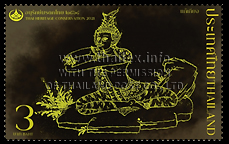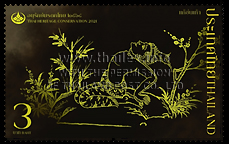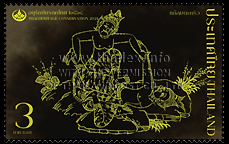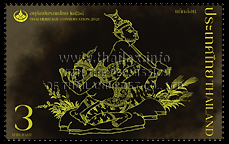|
Thai Heritage Conservation Day
- Thai
Massage (2021)
●




|
Issue Name: |
Thai Heritage
Conservation Day - Thai
Massage |
|
Thai Issue
Name: |
วันอนุรักษ์มรดกไทย -
นวดไทย |
|
Issue Date: |
2021/2564-04-02 |
|
Cause: |
Annual
commemorative stamps for the Thai Heritage Conservation Day
in honour of
Princess
Maha
Chakri
Sirindhorn,
as well as to publicize
Thai
Massage,
a form of body manipulation that alleviates pain through the
release of tension in the muscles. It is a quintessential
Thai art that does not only use internal medicine but also
redresses the balance of energy in the body. Since 2019,
Thai Massage has been recognized by UNESCO to be an
Intangible Cultural Heritage of Humanity. This is Thailand's
second award following the recognition of
Khon,
Thai
classical
dance
theater,
in 2018. |
|
Catalogue Number: |
2021/15-18 |
|
Denomination: |
3 Baht per design |
|
Unused Value: |
3 Baht per design |
|
Complete
Set: |
12 Baht (unused), 4 Baht
(used) |
|
Thailex Collection: |
n/a |
|
Size: |
30 x 48 mm |
|
Quantity of Stamps: |
400,000 pieces |
|
Printer: |
Thai British Security
Printing Public Company Limited, Thailand |
|
Subject: |
A collection of
drawings depicting hermits, known in Thai as
reusi,
in different
yogi
positions, that originate from a book that describes 80
different yogi poses by hermits and which was published in
1838, during the reign of King
Rama III.
These hermit exercises, found in the manuscript commissioned
by King Rama III, serve as the basis for traditional Thai
medical knowledge as found inscribed in texts at
Wat Phra Chetuphon Wimon Mangkhalaraam,
i.e. Wat
Poh in
Bangkok,
which is the
oldest and was once the largest temple in the capital, as well
as its first educational centre and an important training centre for
traditional massage (fig.)
and reflexology
(fig.).
The various hermit poses depict
exercises that were particularly employed after prolonged
meditation sessions to alleviate strains on the body. The
origins of hermit yogi poses can be traced back to the era
of King
Rama I.
This is evident not only in ancient medical recipes but also
in a collection of hermit sculptures
(fig.)
found in Wat
Poh
and
which in the past were used as didactic material.
These
hermits
(fig.)
in various poses are found in
a
section of the temple garden and represent various exercises
that
promote
physical health (fig.),
akin to similar statues of reusi at
Wat Bang Peng Tai
(fig.).
People were encouraged to study these yoga stretches as a
means to combat illness and enhance overall health. Later
on, King Rama III, alongside a Royal Scholar, composed a set
of poems to provide instructions and acknowledge the
beneficial qualities of these poses. The
postage stamps feature: 1.
relief of bodily discomfort;
2. relief of plantar pain;
3. relief of muscle cramp;
and 4. relief of distention of abdominal swelling caused by
fluid being trapped in the scrotum. |
|
Related Link: |
massage,
yogi,
reusi,
Rama III,
Rama I,
Wat Phra Chetuphon,
Wat
Poh,
Bangkok,
Wat Bang Peng Tai |





|